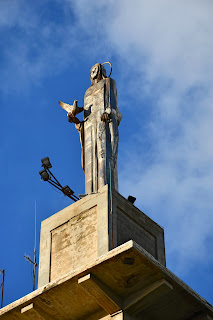Mallorca – Day 3: Palma
Having seen a decent amount of Palma yesterday, we went about our day at a leisurely pace. In the morning, we checked out of our hotel and rode the exhilarating car-lift to the ground floor, after which we drove to the hill of Nuestra Señora de la Paz. My dad had spotted the statue from a distance the other day, and seeing as we had nothing else to do before everything else opened, we thought we might as well make a visit. Had we not stopped by, I likely would never have learned how ugly the statue really looks from up close.
The steepness and
narrowness of the road to the statue surprised us, but we were lucky to have
gone early enough to encounter very few fellow drivers. Whenever such meetings
occurred, we made a studious effort to remain on the inside of the road,
avoiding a closer brush with the steep cliff below.
Since the view was
restricted by trees, we did not stay long at the lookout point but continued to
Bellver Castle. Remarkable for its circular plan, the castle dominates the
skyline of Palma de Mallorca. While it only opens at ten on Sundays during the
winter months, the entry is free then, and we used our relatively early arrival
to rush through the gate and climb to the roof before the other tourists
managed to catch up. However, this was only after we spent some twenty minutes
loitering about and taking pictures from the outside while waiting for the gate
to open.
Our third stop for the
day was another destination on the outskirts of Palma de Mallorca: the Miró
Foundation. Purchased with the money Miró received for winning the Guggenheim
International Award, the original house gradually expanded to a sprawling
complex of buildings and a large garden. Some of the villas reflect Miró’s
penchant for bright colours, while the main building boasts a roof with
impressive water features. Our visit to the museum reminded me that I never
really liked Miró, whose art just seems like squiggles to me, and we did not
stay very long to admire the unintelligible shapes.
We returned to Palma
shortly before noon. Taking in a few more views of the cathedral from the windy
promenade, I feared we might be impaled by a falling palm frond at any moment.
Nevertheless, we survived, which allowed us to continue with our programme. When
we approached the cathedral, we found it closed for mass, and the man at the
door told us that no visits would be allowed the entire day. My dad was very
insistent about going in, however, and so we joined the congregation for a
short while. I was very apprehensive about leaving early, as I feared being
called out by the man who had let us in just a few minutes before; doubtlessly
he would rail at our half-assed commitment to organised religion.
Just opposite the
cathedral, we also made a visit to the Royal Palace of Almudaina, whose
foundation dates to the island’s Muslim period. In many ways, it is a standard
royal residence, though some of the objects on display are quite interesting: a
golden serpent helmet, for example, and a tapestry that features a turkey from
the New World. From the Royal Palace, we continued along the sea, passing by
the Guildhall and the Fortress of Saint Peter. We wondered why the Parc de Sa
Feixina was not advertised in any of our guidebooks until we read the
inscriptions on the monument and discovered it was built during the Franco Era.
Finally, we reached El
Jonquet, a quiet neighbourhood dominated by a row of old windmills with a
distant view of the cathedral. It was a good note on which to end our ramblings
around Palma, and we returned to the car park soon after. Since we still had a
little more time to kill, we made an impromptu ride to Algaida to take a look
at its church and windmill before heading to the airport.





















































Comments
Post a Comment